
chapter three
QUICK
“Quick” is a vague label in our hurried times, and my idea of speedy cooking may not match yours. So, for the sake of clarity, in this chapter I term thirty minutes or so spent making a home-cooked recipe from scratch as “quick”; any less is really pushing it unless you’re simply throwing a salad together or happen to have a nifty sous chef on hand. Speed doesn’t have to mean compromise or stingy portions—there are substantial and satisfying recipes here—but producing supper on the double will require a little forethought and a handful of good tools.
The difference between most home cooks versus the professionals? Keeping a good chef’s knife sharp. (Arguably, properly seasoning food, too, but that is a separate gripe.) If your knife is sharpened and your hand practiced, you really will need little more in the way of equipment.
In the interests of chopping or blending modest quantities in seconds, a mini food processor will prove even more useful than its larger equivalent, as well as cheaper. I blend many a pesto or curry base in mine . . . failing that, use a mortar and pestle. . . . Otherwise, simply rely on your decent chef’s knife which, naturally, has a deep enough blade to turn on its side for crushing and bruising ingredients. Keep chopping and you will get faster at it, I promise.
A box grater, a speed peeler and a shredder version of the same will all work double-time for you; they are cheap and make short work of crisp vegetables. Hand blenders take up little space but will save you the bother of blending soup in batches; you can simply blend a quick soup in the pot with very little waste or cleaning up.
Incidentally, if you ever have five extra minutes when crushing garlic, chopping chile or grating ginger, fill the indentations of an ice cube tray with any excess. Freeze, then transfer into freezer bags and keep on hand to buy time on another, busier day.
The vast majority of quick recipes are born on a hot stove top, rather than in the oven. Hardly surprising, when Asian and East Asian countries with their strong tradition of quick-fire cooking and street food provide so much inspiration. Getting everything prepped and lined up before you start to cook is so important for speed and never more vital than when stir-frying. You will have the heat up as high as it will go so it’s essential to stand by, stirring when needed to prevent ingredients catching. Reducing the heat to give you time to chop the next ingredient will lead to a waterlogged wokful. Either way, dawdling over a stir-fry won’t end well.
A wok is extremely useful then, but you will also need a form of sturdy frying pan or griddle to bring up to smoking-hot temperatures. A generous-sized version, suited to cooking large batches at once, will be a sound investment. Ditto at least one large, robust roasting pan that won’t crowd its contents and is built to withstand fiery roasts such as those in this chapter—and even the odd spell directly on the cooktop—without buckling.
This is a book to celebrate vegetables and that applies to this Quick chapter as much as to any of the others. Choose varieties wisely, or simply slice them thinly to get them cooked in double-quick time. Green vegetables, salads and shoots, brassicas, peppers, corn, tomatoes, or any other vegetables suited to eating raw are ideal for hasty cooking methods; they will need little more than a flash in the pan and a confident hand with the spices and aromatics. Root vegetables and tough tubers, more commonly suited to slower cooking, shouldn’t be ruled out though. They can be adapted to suit a quicker cooking style but will only be your friends if you cut them up small or slice them very thinly to expose as much surface area as possible.
It will serve you well to memorize a few simple recipes that can be adapted to suit mood and season. My swift and bold staples include egg-fried rice (get into the habit of cooking extra rice and chill what you don’t need, ready to revive the following day); the simplest rice paper rolls with a satay-style nut butter dip; quick tofu or lentil patties with salad and interesting homemade pestos (throw in some kale or watercress or chile and vary the nuts or seeds) to be stirred through anything from pasta and roasted tomatoes to cooked grains and sautéed vegetables.
Eggs are an obvious godsend for the hurried, and hungry, cook. I suppose it’s a rare kitchen supper–style recipe that wouldn’t welcome an extra fried or poached egg on top. From this chapter, I’d recommend adding an egg to the Twice-Cooked Leeks with Goat Curd, Horta on Toast with Sweet Pepper and Chile Jam or even the Vegetarian Pad Thai, if you are ravenous. But, because of those Asian and East Asian influences, there is a lot of egg-free and dairy-free fodder in this chapter, too. Try the Crisp Tofu Stir-Fry with Black Beans; it is vegan and proud.
Once that initial assembling, prepping and chopping time is out of the way, this chapter is vegetarian cooking as theater. Enjoy showing off with some fast but simple techniques and flashy flavors.
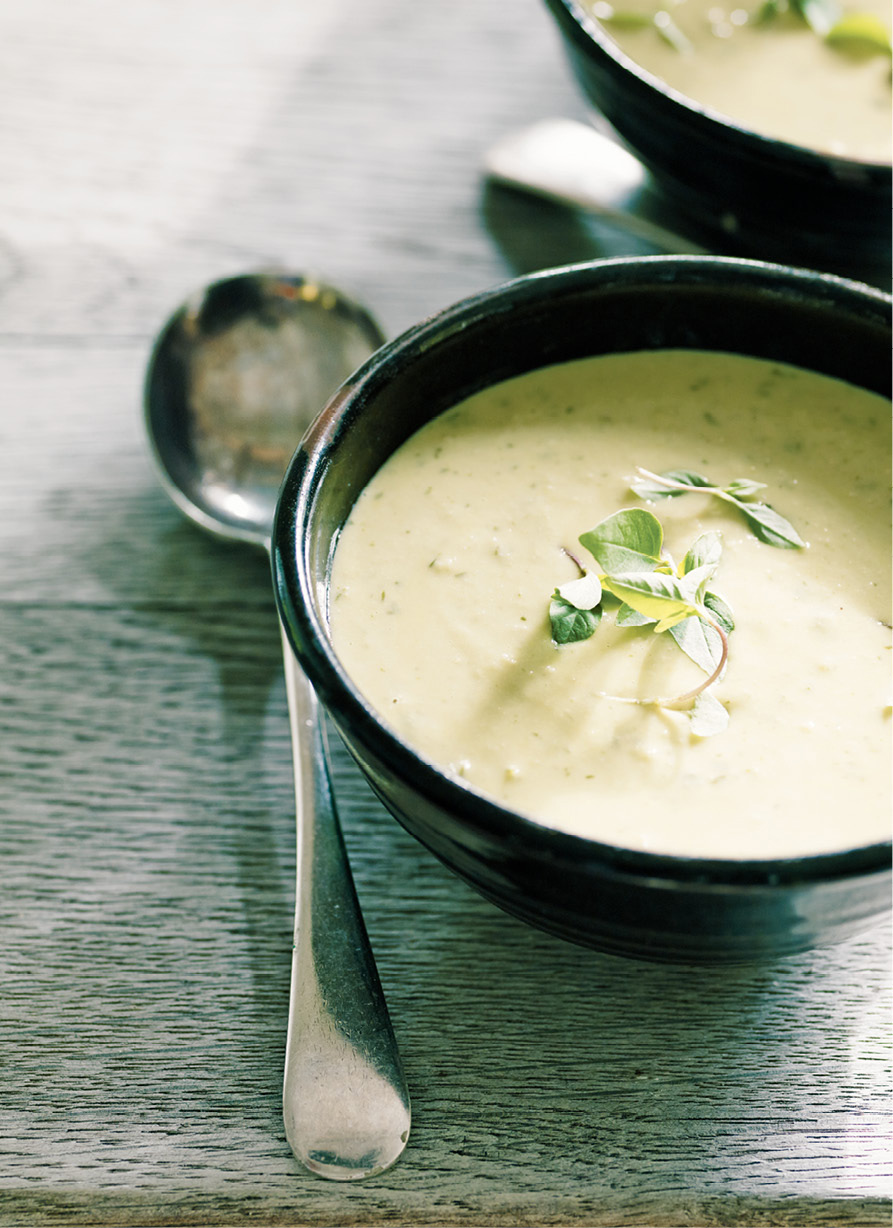
Thai Green Sweet Corn Soup
Considering its lively base, loosely borrowed from a Thai green curry paste, this is a surprisingly soothing (vegan) soup thanks to the richness lent by sweet corn, coconut and cashews. If you need to cut corners here, use a couple of spoons of a good-quality store-bought Thai green curry paste and 1½ cups (250 g) frozen corn kernels in place of the fresh varieties in the recipe.
Serves 4
• ¾ cup (100 g) roughly chopped cashews
• 2 shallots, roughly chopped
• 1 fat garlic clove, smashed
• 1-inch (2.5 cm) piece fresh ginger root, peeled and roughly chopped
• 2 fresh or frozen makrut lime leaves
• 2 lemongrass stalks, outer layers removed, inner roughly chopped
• 1 green chile, deseeded if you prefer, roughly chopped
• Small bunch of cilantro, stalks and leaves separated
• 2 tablespoons peanut oil
• 2 large ears sweet corn, kernels sliced off and corncobs discarded
• One 13.5-ounce (400 ml) can coconut milk
• 1⅔ cups (400 ml) vegetable stock (fill the emptied coconut milk can to measure out)
• 1 or 2 squeezes of lime juice, or to taste
• Small handful of baby Thai basil or cilantro leaves, to serve
- Cover the cashews with water and set aside to soften for 15 minutes.
- Blend the shallots, garlic, ginger, makrut lime leaves, lemongrass, green chile and cilantro stalks together in the small bowl of a food processor. Scrape the processor bowl down a couple of times between pulses, until the mixture is very finely chopped.
- Put the peanut oil in a large saucepan set over medium-low heat. Add the blended mixture and fry gently for 10 minutes, stirring often, until soft and fragrant, but not highly colored.
- Drain the cashews and add to the pan, cooking for a couple of minutes. Transfer in the corn and cook for 5 minutes more, stirring often. Now pour in the coconut milk and vegetable stock. Bring to a boil, then reduce the heat and simmer gently for 15 to 20 minutes. Stir in the cilantro leaves.
- Blend in the pan until most of the soup is smooth, using a hand blender, or keep half a cupful back and blend the rest in 2 batches in a freestanding blender. Either way, keeping a small amount of soup unblended adds welcome texture.
- Taste and adjust the seasoning as needed: A squeeze of lime juice should perk the flavors up, so add a little, then taste and see if you want any more. Divide between warmed bowls and scatter with baby Thai basil or cilantro leaves, for extra fragrance.
Blackened Baby Eggplant with Summer Herbs
A delicate supper for warm evenings. I suggest using the widely available baby eggplant, but slices of larger, regular eggplant will work perfectly, too. Brush them with olive oil and cook in a smoking-hot griddle or frying pan until tender and well marked on both sides. The more dramatic-looking wild rice is particularly good here in place of the brown, though it will take longer to cook.
Serves 4
• 1 fresh bay leaf
• 1 cup (200 g) brown rice, rinsed
• Sea salt and freshly ground black pepper
• 8 to 12 baby eggplants, depending on size
• Olive oil
• 1 large shallot, finely chopped
• 10.5 ounces (300 g) baby plum tomatoes
• 3 tablespoons red wine vinegar, or to taste
• Extra virgin olive oil, to taste
• Handful of chervil or mint leaves
• ¼ cup (60 g) plain yogurt
• 1 tablespoon light tahini
• Small handful of flat-leaf parsley leaves
• Handful of watercress, coarse stalks removed
• ½ teaspoon hot smoked paprika
- Scrunch the bay leaf in your hand to bruise it, then throw it into a medium saucepan with the rice and enough water to cover by a good 1½ inches (4 cm). Add a fat pinch of salt and bring to a boil. Cover, reduce the heat and simmer for 25 minutes, or until the grains are just tender, but not mushy. Drain and remove the bay leaf. Cover and keep warm.
- Preheat the broiler to medium. Pierce a few holes in each eggplant with the tip of a knife. Coat with the regular olive oil and arrange on a rack set in a roasting pan. Broil for 12 minutes, turning the eggplants with tongs every 3 minutes, until blackened on the outside and soft within. Alternatively, cook the eggplants in a smoking-hot griddle pan for about the same amount of time, turning until evenly blackened.
- Put a splash more regular olive oil and the shallot in a large frying pan. Cook over medium heat for 5 minutes, stirring often, until softened but not colored. Add the tomatoes, increase the heat and cook, stirring now and then, for 5 minutes, until they begin to burst. Use the back of a spoon to crush about half the tomatoes roughly. Remove the pan from the heat and stir in 1 to 2 tablespoons of the vinegar and a good splash of extra virgin olive oil. Finely chop a couple of tablespoons’ worth of the chervil or mint leaves and stir them in, too, seasoning the dressing well.
- Combine the yogurt, tahini and remaining vinegar, to taste, with 2 to 3 tablespoons of water to make a dressing with the consistency of light cream. Finely chop the parsley and stir this in, too.
- Divide the rice between warmed plates, topping with 2 or 3 eggplants and the warm tomato dressing. Tuck a little watercress in beside the rice. Finish with spoonfuls of the yogurt-herb mixture, a little more extra virgin olive oil, pinches of paprika and the remaining chervil or mint leaves.
Twice-Cooked Leeks with Goat Curd
Giving leeks a quick blanch before charring them in a griddle pan renders them tender inside with a smoky, caramelized outer in no time. Perfect eaten, as here, with a simple dressing and a mousse-like goat curd. To take the dish from starter or side dish to main course, serve the leeks on a bed of very soft polenta, in which case you might want to swap the oil in the dressing for melted butter, whisking the dressing together in the warm pan in which you melted the butter.
Serves 4 as a starter or side dish
• ½ cup (75 g) shelled hazelnuts
• 6 medium leeks, trimmed
• Sea salt and freshly ground black pepper
• 3 fresh bay leaves, scrunched up
• ¼ cup (60 ml) cold-pressed canola oil, plus more to coat
• 1 tablespoon chopped tarragon leaves
• 1 teaspoon whole-grain mustard
• 1 teaspoon finely grated zest and the juice of 1 unwaxed lemon
• ⅔ cup (100 g) goat curd, or soft goat cheese
- Preheat the oven to 375°F (190°C).
- Spread the hazelnuts out on a tray and roast for 5 to 6 minutes, shaking the tray once as they cook to a golden brown. Let cool slightly, then roughly chop and set aside.
- Halve the leeks from top to bottom, washing them well to remove any grit stuck between the leaves.
- Bring a large saucepan or stockpot of water up to a rolling boil. Throw a generous pinch of salt and the bay leaves into the water, followed by the leeks. Boil for 4 to 5 minutes, until tender, then transfer into a colander and drain thoroughly. Coat lightly with oil.
- To make the dressing, whisk together the ¼ cup (60 ml) of canola oil, the tarragon, mustard and lemon zest and juice, seasoning to taste.
- Put a griddle pan over high heat until smoking hot. Lay half the leeks out in the pan and weigh down with the base of the saucepan you used to blanch them. Cook for 1 to 2 minutes, until well marked with griddle lines, then turn and repeat on the other side. Remove to a plate and cook the remaining leeks in the same way.
- Season the griddled leeks well and divide between warmed serving plates. Spoon the dressing over and top with spoonfuls of goat curd and a scattering of the toasted hazelnuts.
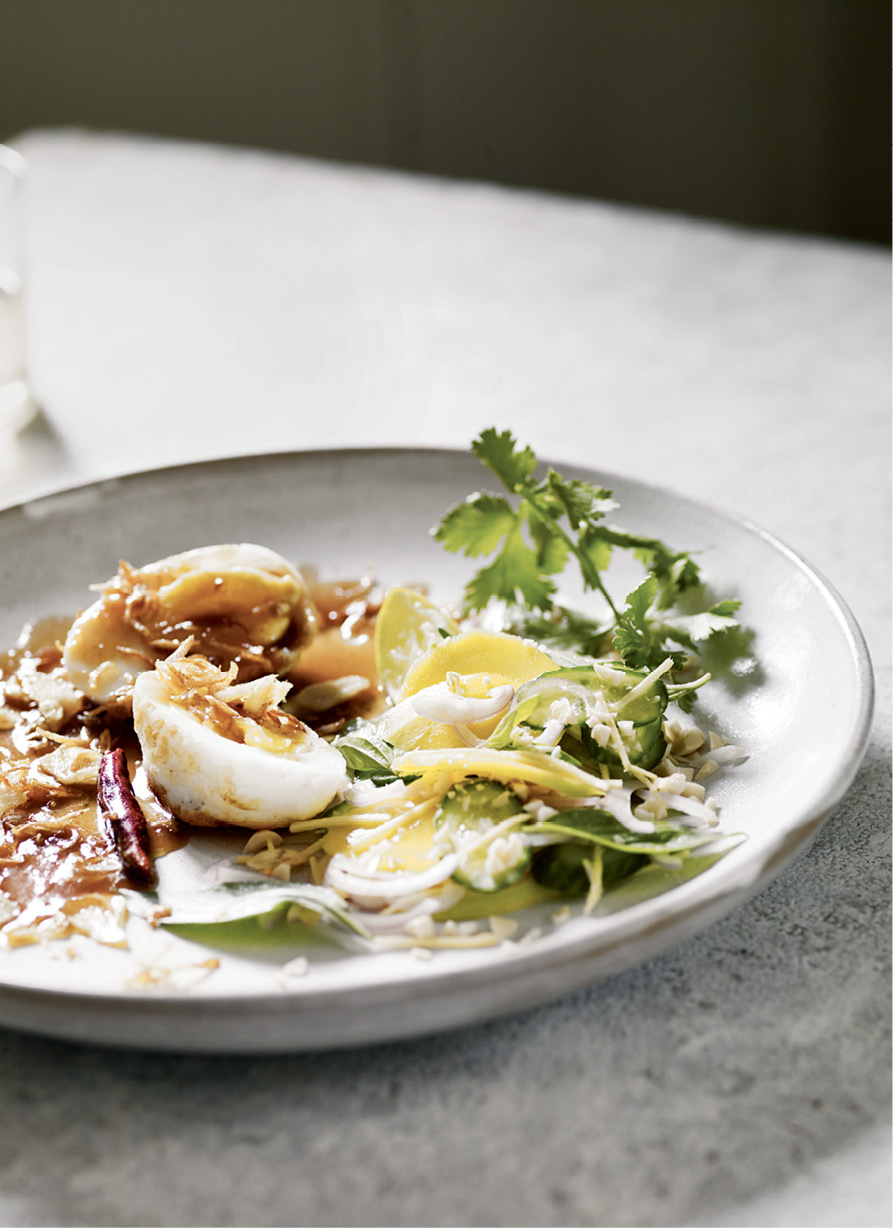
Son-in-Law Eggs with Green Mango
Various theories float around to explain the name. . . . The more risqué may put you off your supper; the most popular (and placid) version has this pegged as a dish with which to impress prospective in-laws. It is a perfect summation of why it is a travesty to exclude vegetarians from Southeast Asian recipes traditionally seasoned with fish sauce. Granny Smith apples make an easy substitute for green mangos.
Serves 4 generously
• ⅓ cup (50 g) unsalted peanuts
• 4 duck eggs, not newly laid, at room temperature
• Peanut oil
• 1 dried chile
• Handful of little red Thai shallots, finely sliced
• 2 garlic cloves, finely sliced
• 1- to 1½-inch (2.5 to 4 cm) piece fresh ginger root, peeled and sliced into fine matchsticks
• ½ cup (100 ml; ½ batch) Sweet-Sour Tamarind Sauce
• Handful of Thai basil leaves
• 2 little green mangos, peeled and sliced around the pit
• 2 baby cucumbers, sliced
• 1 lime, ½ juiced, ½ cut into slim wedges
• Sea salt
• A few sprigs of cilantro, optional
- Preheat the oven to 375°F (190°C). Spread the peanuts out in a baking pan and roast for 5 to 6 minutes, until golden. (Set a timer for 4 minutes and check every minute from then on.) You can do this in a dry pan on the stove, but I find roasting nuts lends a deeper flavor. Either way, let cool before chopping quite finely, or crushing with a mortar and pestle.
- Bring a pan of water—enough to cover the eggs—to a boil, then reduce the heat to a gentle simmer. Gently lower the eggs into the water and cook for 7 minutes (or 30 seconds more or less if they are very large or particularly small). Drain, then peel under cool, running water and pat dry.
- To make the sauce, add a good pour of peanut oil to a wok or frying pan—enough to cover the base generously—and set over medium heat. Throw in the dried chile and cook for about 10 seconds, until a shade darker. Remove to a plate lined with paper towels, leaving the oil behind. Now add all but 1 tablespoon of the sliced shallots to the wok and fry slowly for 5 to 7 minutes, stirring, until they have become a deep and rich golden color and appear shriveled. Remove to the paper towel with a slotted spoon. Add the garlic and half the ginger to the wok and cook slowly for 2 to 3 minutes, until pale golden and crisp. Add to the shallots, first draining them of excess oil. Lastly, add the eggs to the wok, cooking slowly until golden-brown on all sides and puffed in places. Drain on paper towels. Wipe the wok or pan out with paper towels, then return to a low heat. Add the tamarind sauce and warm through for a minute or so.
- Toss the reserved, uncooked shallots and ginger with the Thai basil, green mangos, cucumbers, lime juice to taste and a pinch of salt. Halve the eggs and divide between individual plates with the sauce. Shower with the fried shallot mix and the salad, adding the peanuts. Add a cilantro sprig or 2 if you like, and tuck in a lime wedge, for squeezing over as you eat.
Smoky Thai-Style Tofu Cakes with Green Pod Salad
A light, aromatic lunch or supper. Tofu is surprisingly filling, but you might want to add steamed rice on the side to keep larger appetites happy. If you can’t find frozen or fresh makrut lime leaves (incidentally, the fresh ones I used for this were grown not three miles from where I sit in East Sussex), finely grate the zest of the lime used in the dressing and stir that in instead. Plain, firm tofu works just as well as smoked.
Serves 4
For the tofu cakes
• 1- to 1½-inch (2.5 to 4 cm) piece galangal or fresh ginger root, peeled and chopped
• 1 large garlic clove
• 1 red chile, deseeded
• 2 lemongrass stalks, trimmed and sliced
• Sea salt and freshly ground black pepper
• 4 tablespoons crunchy peanut butter
• 2 fresh or frozen makrut lime leaves, very finely sliced
• 1 medium carrot, finely grated
• 14 ounces (400 g) firm, smoked tofu, crumbled
• 2 eggs, lightly beaten
• 3 tablespoons peanut oil
For the salad
• ⅔ cup (100 g) edamame or soybeans, fresh or frozen
• Juice of 1 lime
• 1 to 2 tablespoons light soy sauce
• A little sugar or honey, optional
• 7 ounces (200 g) sugar snap peas, sliced on the diagonal
- With a sturdy mortar and pestle, pound together the galangal, garlic, chile and lemongrass with a generous pinch of salt to form a paste. You could also use a mini food processor here, stopping to scrape down the sides now and then. Dump into a mixing bowl (don’t wash the mortar out!) and stir in 3 tablespoons of the peanut butter, the makrut lime leaves, grated carrot and tofu, working the mixture together with the back of a spoon. Taste and season accordingly with salt and pepper, then stir in the eggs.
- Scoop slightly heaping soup spoonfuls of the mixture up, pressing them together firmly to make 12 patties about 2 inches (5 to 6 cm) in diameter and ⅜ inch (1 cm) thick. Space out on a plate.
- To make the salad, steam the edamame for 4 minutes, then drain well. Stir together the remaining 1 tablespoon of peanut butter, the lime juice and soy sauce to taste in the mortar you used to make the patties or, failing that, a mixing bowl. You can add a little sugar or honey to balance, if you like, but I think astringent is good here. Toss the raw sliced sugar snap peas and the edamame through this dressing.
- Put a large frying pan over medium heat, add half the oil and fry half the patties for 2 to 3 minutes on the first side, flipping over with a spatula when golden brown and cooking for 2 to 3 minutes more. Remove to a plate and keep warm. Repeat with the remaining oil and tofu cakes. Serve the green pod salad with the hot tofu cakes.
Rye Migas, Baked Feta and Hot Caper Salsa
Bold flavors and textures for a late summer meal. It is so important to use a decent (stale) bread with a bit of body here. Anything flimsy will turn soggy once doused in water. Use a good sourdough, rye-based if you can find it, for a mild, sweet flavor. Swap green beans, halved through the middle, for the kale if you prefer a sweeter vegetable; add a splash of water as they cook and allow an extra minute or so in the pan.
Serves 4
• 6 slices (250 g) rye sourdough bread, stale if possible, crusts removed
• 1½ tablespoons capers
• 1 small unwaxed lemon
• 1 shallot, finely chopped
• 1 green chile, finely chopped
• Leaves from 4 sprigs of oregano, chopped
• Freshly ground black pepper
• 14 ounces (400 g) feta, drained
• Olive oil
• 1 fat garlic clove, chopped
• 6½ cups (200 g) sliced kale, ribs removed
• ½ teaspoon sweet smoked paprika
- Preheat the oven to 375°F (190°C).
- Cut the crustless bread into rough cubes and transfer to a mixing bowl. Sprinkle with ¼ cup (60 ml) water, toss gently and set aside for 15 minutes.
- Meanwhile, rinse and drain the capers to remove excess salt or brine. Slice half the lemon and juice the other half. Combine the lemon juice with the capers, shallot, chile and oregano. Season with lots of pepper.
- Cut the feta into 4 even portions. Place each feta block in the center of a sheet of foil on a baking sheet. Top each with a lemon slice and one quarter of the caper salsa. Drizzle generously with olive oil. Scrunch up the foil to make 4 generously tented but tightly sealed parcels. Bake for 15 minutes, until the cheese has softened.
- Firmly squeeze the water from the bread cubes and put them on a plate.
- Pour enough oil into a frying pan to form a thin film over the base when swirled. Add the garlic, place over medium-high heat, warm through for a few seconds, then throw in the kale. Stir-fry briskly for a couple of minutes until softened. Season, transfer into a bowl and keep warm. Add the bread to the pan with a little more oil. Cook for 5 minutes, stirring almost constantly, until golden and crisp. Season well with pepper (remembering how salty the feta will be) and the paprika.
- Divide the fried bread and kale between warmed plates with the baked feta and salsa.
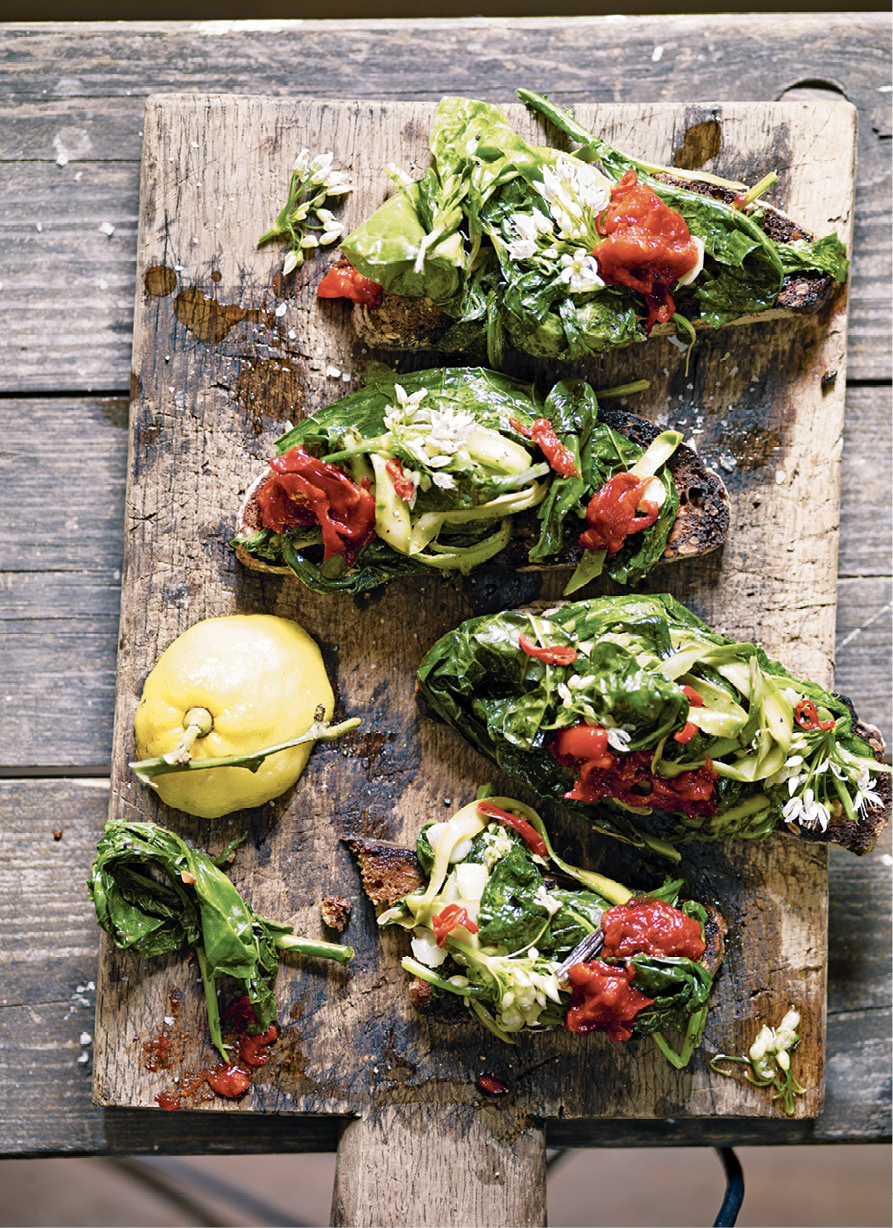
Horta on Toast with Sweet Pepper and Chile Jam
Horta (or khorta) is a Greek catch-all term for greens, usually braised or boiled with plenty of olive oil and lemon. Use any mixture of robust greens you like, wild or not; anything from the first asparagus, to chard or large spinach leaves, to peppery watercress will be superb. A softly poached or fried egg, or a crumble of feta, on top is an excellent addition . . . but ruins the recipe’s current vegan credentials.
Serves 4
• 2 plump garlic cloves, preferably mild, spring garlic
• 1 pound 10 ounces (750 g) mixed green leaves and shoots, such as large spinach leaves, kale, chard, sprue (very young) asparagus, mustard leaves, wild garlic, hop shoots, watercress . . .
• 3 tablespoons olive oil
• 1 mild red chile, finely sliced
• Sea salt and freshly ground black pepper
• 4 large slices of rye or sourdough bread
• Extra virgin olive oil, to serve
• ½ lemon
• Sweet Pepper and Chile Jam
- Finely slice 1 garlic clove and halve the other. Wash well and trim all the greens, removing any coarse stalks and slicing leaves.
- Warm the regular olive oil in a large frying pan over medium heat. Add the sliced garlic and chile and cook for a minute. Throw in the greens and stir-fry for 3 to 4 minutes over medium-high heat, tossing the pan often, until the greens are wilted but still retain a bit of bite. Season well with salt and pepper.
- Toast or broil the bread until slightly charred, then rub a side of each slice with the cut sides of the halved garlic clove.
- Divide the greens between the toasted bread slices—piling them high—with a few drops of extra virgin olive oil, a squeeze of lemon juice and a good spoonful of pepper and chile jam.
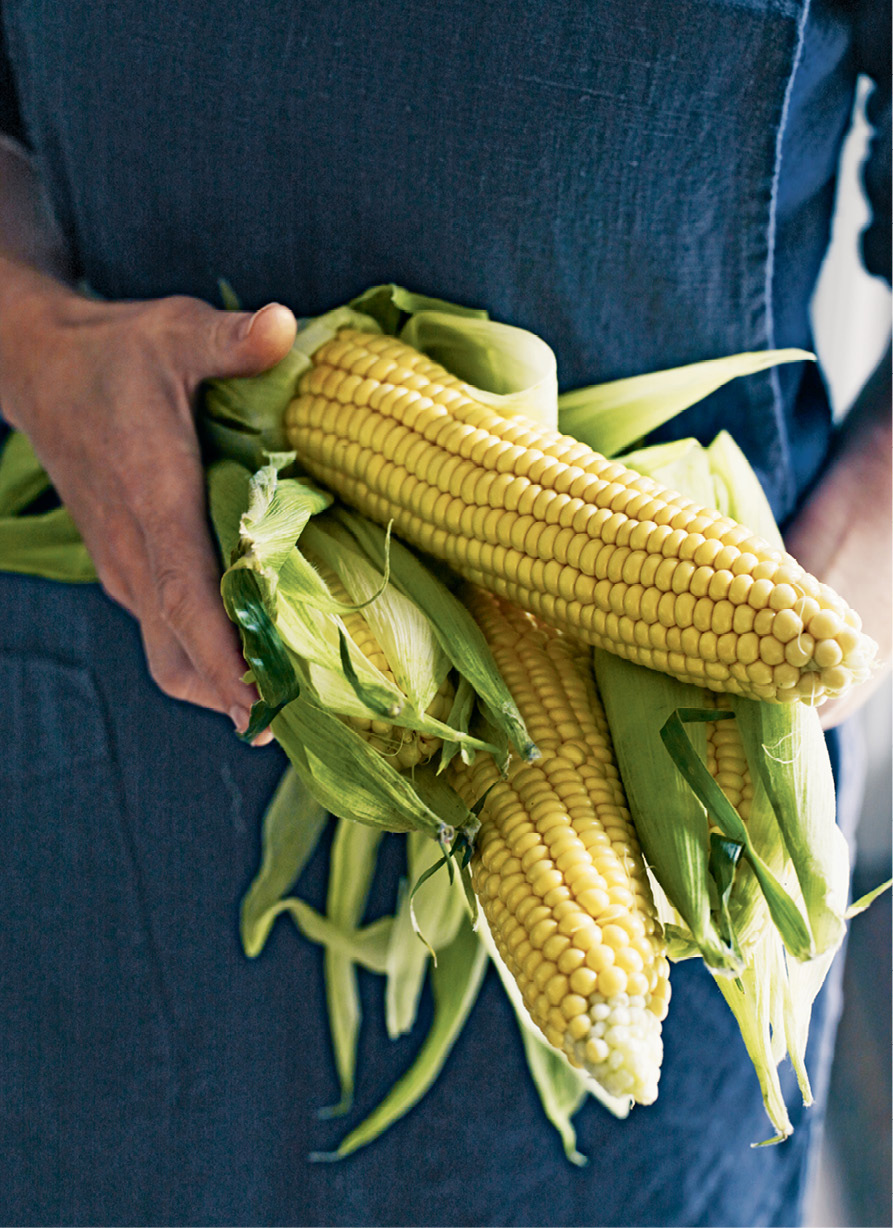
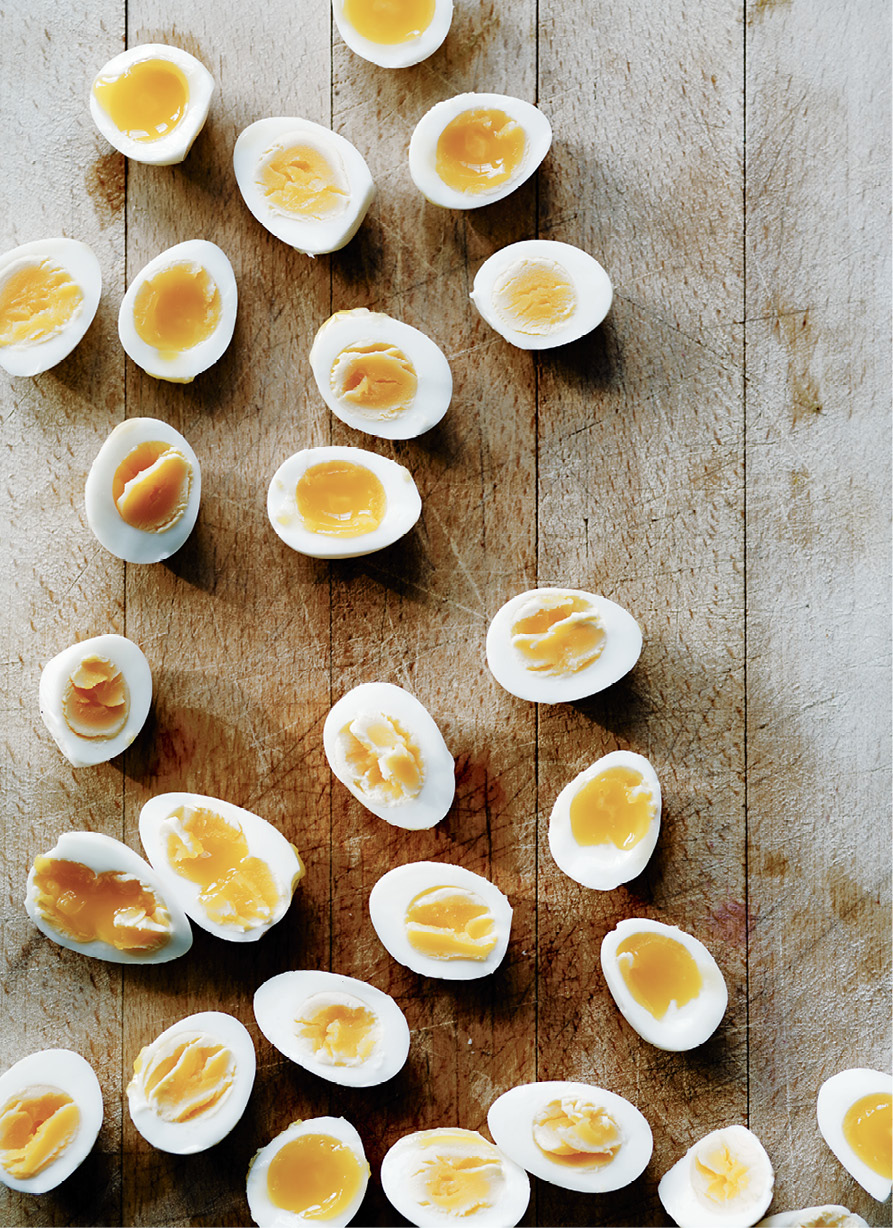
Crisp Tofu Stir-Fry with Black Beans
The trick to this recipe lies in its contrasting textures. Tofu is pressed to extract the water that stops it from forming a crisp coating once fried. When the tofu and vegetables are cooked, barely toss them together, to prevent sogginess. Stalky gai lan (Chinese broccoli) is excellent stir-fried, a bit like firm pak choy, but use any pak or bok choy, broccoli or sliced cabbage. You’ll want steamed rice on the side.
Serves 2 to 3
• 14 ounces (400 g) firm tofu, drained
• 1 tablespoon fermented salted black beans (from Chinese groceries and online)
• 2 garlic cloves, finely chopped
• 1-inch (2.5 cm) piece fresh ginger root, peeled and finely chopped
• 2 tablespoons dark soy sauce
• 3½ tablespoons cornstarch
• 2 tablespoons Shaoxing rice wine
• 2 medium carrots, scrubbed
• 4 scallions, trimmed
• 1 tablespoon five-spice powder
• 1 teaspoon chile flakes
• ¼ cup (60 ml) peanut oil
• 7 ounces (200 g) gai lan (Chinese broccoli), or pak or bok choy, chopped into 2-inch (5 cm) lengths
• Sea salt
- Turn the oven to a very low warming setting.
- Place the tofu on a plate lined with 2 layers of paper towels. Cover with another 2 layers of paper towels, then another plate, and press firmly. Weigh down with a couple of unopened cans. Set aside for 10 minutes.
- Rinse and drain the salted black beans. In a small bowl, mash them with the garlic, ginger and soy sauce. Put ½ tablespoon of the cornstarch in another small bowl, then gradually add 3 tablespoons of water and the rice wine. Slice the carrots on a steep diagonal. Halve the scallions from top to bottom and cut into thumb-height lengths.
- Combine the remaining 3 tablespoons cornstarch, the five-spice and chile flakes on a plate.
- Pat the tofu dry with more paper towels and cut into ¾-inch (2 cm) cubes. Roll the cubes in the cornstarch mixture until well coated on all sides, dusting off the excess. Put 3 tablespoons of the oil in a large frying pan or wok. Turn on the heat under the pan to medium-high and fry the tofu cubes, turning carefully with tongs every minute or so, until crisp and golden on all sides; this will take about 5 minutes. Transfer to a plate lined with paper towels and keep warm in the oven. Wipe the pan out.
- Put the remaining 1 tablespoon of oil in the pan and set over high heat until smoking. Keeping the heat very high and the ingredients moving throughout, throw in the carrots and stir-fry for 30 seconds or so. Add the gai lan and cook for another 30 seconds. Stir in the black bean mixture and the scallions and cook for 30 seconds, then stir and add the rice wine mixture. Stir-fry for a minute or so until thickened and glossy, then season with a little salt and divide between warmed plates with the crisp tofu.
Let’s be real: Tofu doesn’t get the best reception outside its native East and Southeast Asia, where it is understood and justly celebrated. When treated correctly, this valuable, protein-dense weapon in the vegetarian or vegan cook’s arsenal is rich in B vitamins. In its simplest form, it is made from only soy milk and the coagulant nigari (magnesium chloride). (As with any packaged food, if you worry about how it is made or what it contains, check the label and stay away from additives you don’t want.)
The problem—in Western countries at least—isn’t just that we’re not sure what to do with it, but also that the tofu available to us in the recent past was rarely of the best quality. We can now buy good, firm tofu in supermarkets and smoked or marinated tofu in specialty shops. Those firm varieties are perfect in stir-fries, absorbing sauces like a sponge.
Go to any Chinatown and you’ll find frozen, spongy tofu to simmer in broths; inari pouches to swell with sushi rice; fermented, salted jarfuls in sauce or not; dried sheets to use as dumpling wrappers, to name a few. (Don’t bother with the musty blocks of silken tofu in shelf-stable packages.)
Let’s assume, for simplicity’s sake, we are dealing with blocks of firm tofu (whether smoked or flavored is up to you). These crumble beautifully, ready to scramble as you would eggs, or bind patties such as Smoky Thai-Style Tofu Cakes with Green Pod Salad. Whatever recipe you use, don’t be shy. Add bold flavors, such as ginger, garlic, sesame oil, lime leaves, black beans, Szechuan pepper, wasabi or chile, and use natural sweeteners (honey, palm sugar and so on) to glaze. Less conventional, but no less successful, are typically Asian spices such as cumin and coriander, or complex curry blends, or—from even further afield—smoky chipotle. You simply can’t be coy with tofu, or your dish will be bland.
Texture is one of tofu’s most interesting characteristics. Again, I will look at the firm blocks, though I give a recipe for steaming silken tofu doused with a sweet-sharp-salty dressing in the Raw-ish chapter (Silken Tofu with Seaweed Dressing), celebrating its delicate wobble. Firm tofu is particularly useful to the cook; not only will it stand up to a tumble around a frying pan or flash under a broiler, it will hold a flavorful coating, adding a second texture when crisp outer gives way to soft inner. Cornstarch and potato flour prove to be excellent coatings, frying up crisp and golden. Increase the contrast (and live life on the edge) by triple-coating softer cubed tofu in salted, spiced flour, then beaten egg, then bread crumbs. Fry until crisp, then toss with a fiery relish, such as Sambal Oelek or Caramelized Peanut Sauce. Offer lime wedges and soy sauce on the side. Delicious!
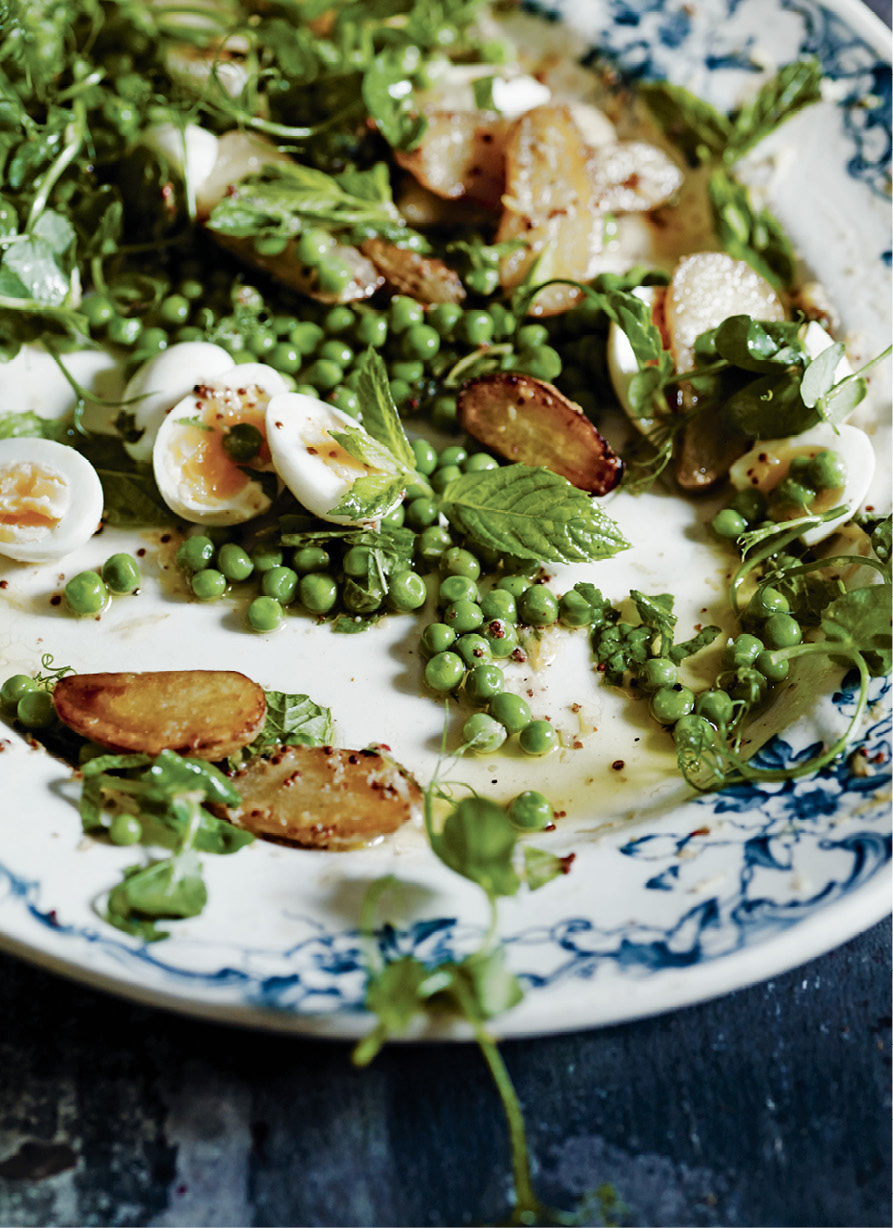
A Summer Salad
Familiar flavors run riot in this warm salad: tender pea shoots against hot peas and cool mint; a sharp, mustard-citrus dressing; new potatoes crisp from the pan; and soft-boiled quail eggs. Try to make sure the eggs you buy aren’t too fresh, or you’ll have a terrible time peeling them. (If they are older, air pockets develop inside, separating the membrane from the white and making them easier to peel.)
Serves 4 generously
For the dressing
• Finely grated zest and juice of 1 small unwaxed lemon
• 2 teaspoons whole-grain mustard
• ¼ cup (60 ml) extra virgin olive oil
• Sea salt and freshly ground black pepper
For the salad
• 1 pound (500 g) new potatoes
• Handful of mint leaves, shredded if large, plus 1 sprig of mint
• 12 quail eggs (see recipe introduction)
• 1½ cups (200 g) shelled peas, fresh or frozen
• 2 tablespoons mild olive oil
• 2 large handfuls of pea shoots
- To make the dressing, shake the lemon zest and juice, mustard and extra virgin olive oil together with 1 tablespoon of water in a lidded jar and season with salt and pepper to taste. Set aside.
- Put the potatoes in a saucepan with enough cool water to cover generously. Add a large pinch of salt and the mint sprig, bring to a boil, reduce the heat and simmer for about 15 minutes, depending on size, until almost tender to the point of a knife.
- Have a bowl of ice water ready in the fridge. Bring a small pan of water to a rolling boil. Have a timer ready and set it as you drop the eggs in. Boil them for exactly 3 minutes, then transfer to the ice water bowl with a slotted spoon. Carefully peel, then cut in half. Separately steam the peas, or simmer them in salted, boiling water, for 2 to 3 minutes. Drain well.
- Drain the potatoes thoroughly and slice into thick coins as soon as they are cool enough to handle (or wear rubber gloves and slice immediately). Put a frying pan over high heat and add the regular olive oil. Fry the potato slices on both sides, until they are crisp and golden.
- Gently toss the warm potatoes and peas with the dressing, shredded mint, pea shoots and halved quail eggs and serve on a platter or in a serving bowl.
Stalk Soup
I have kept simplicity and comfort at the forefront in this vegan soup, braced with almonds and rice to give a silky texture without added cream. If you want to vamp up the flavors, strong cheese is an option: 1½ cups (150 g) grated cheddar or crumbled blue cheese, stirred into the blended soup over gentle heat, pairs beautifully. Or keep it dairy-free and top with caramelized onions or spoonfuls of vegan pesto.
Serves 4 generously
• 1 pound 10 ounces (750 g; 2 smallish) stalky broccoli heads
• 1 large leek, washed and sliced
• 1 celery stalk, chopped
• 2 tablespoons olive oil
• Sea salt and freshly ground black pepper
• ⅓ cup (50 g) chopped almonds
• 3 tablespoons basmati rice
• 1 quart (1 L) vegetable stock
• Handful of sliced almonds
• Handful of watercress
• Squeeze of lemon juice
- Roughly chop the broccoli heads, including the stalks. Set aside.
- In a large saucepan or casserole set over medium-low heat, soften the leek and celery in the olive oil with a pinch of salt. They will take about 10 minutes to soften and become sweet. Add the broccoli, chopped almonds and rice, turning to coat in the oil for a minute or so. Pour in the stock, then bring to a boil, partially cover, then reduce the heat and simmer for 20 minutes.
- Meanwhile, toast the sliced almonds in a small frying pan set over medium heat, tossing the pan often until the nuts are deeply golden. Set aside.
- Stir the watercress into the cooked soup and simmer uncovered for a minute more, then remove from the heat and blend until very smooth, either in the pan using a hand blender, or in batches in a freestanding blender. Reheat the soup gently, then add the lemon juice and adjust the seasoning to taste. Serve scattered with the toasted sliced almonds.
Celery Root and Chestnut Soup with Oregano
With good bread and butter on the side, this autumnal, velveteen soup makes for a handsome kitchen supper on a cold night. It does, however, also feel fancy enough to masquerade as a starter, in which case you can stretch it to serve six in delicate portions. Do add the crème fraîche and the final, buttery chestnut flourish if this is destined for a dinner party or similar.
Serves 3
• 1 large celery root, about 1½ pounds (700 g) total weight, peeled and cubed
• Squeeze of lemon juice, plus more if needed
• 2 celery stalks, finely chopped
• 1 onion, finely chopped
• 2 garlic cloves, chopped
• 1 teaspoon olive oil
• 3 tablespoons salted butter
• 2 cups (200 g) cooked, peeled chestnuts
• Leaves from 4 sprigs of oregano
• 1 quart (1 L) vegetable stock
• Small handful of green celery root or celery leaves, if you have them
• Sea salt and freshly ground black pepper
• 3 teaspoons crème fraiche, optional
- Drop the cubed celery root into a bowl of cold water with the squeeze of lemon juice. This will keep it from browning.
- In a large saucepan, gently cook the celery, onion and garlic in the oil and half the butter for 10 minutes, until soft and translucent but not brown. Stir in 1½ cups (150 g) of the chestnuts, half the oregano and the drained celery root and cook for 5 minutes more. Pour in the stock. Bring to a boil, then reduce the heat and simmer for about 15 minutes.
- Purée in a blender until completely smooth, either in the pan using a hand blender, or in batches in a freestanding blender. For a truly velvety soup, pass through a sieve as well. Return to the original saucepan.
- Meanwhile, roughly crumble the reserved chestnuts. Melt the remaining butter in a frying pan set over medium heat until foaming. Add the chestnuts and remaining oregano and cook for a few minutes, stirring often, until turning golden. Stir in the green celery root or leaves, if you have any, and cook for a minute more, until the chestnuts are crisp.
- Adjust the seasoning in the soup with salt and pepper; you may wish to add a spike of lemon juice to brighten the flavors. Reheat gently and divide between warmed bowls. Finish each serving with a spoonful of buttery, fried chestnuts and oregano and 1 teaspoon crème fraîche, if you like.
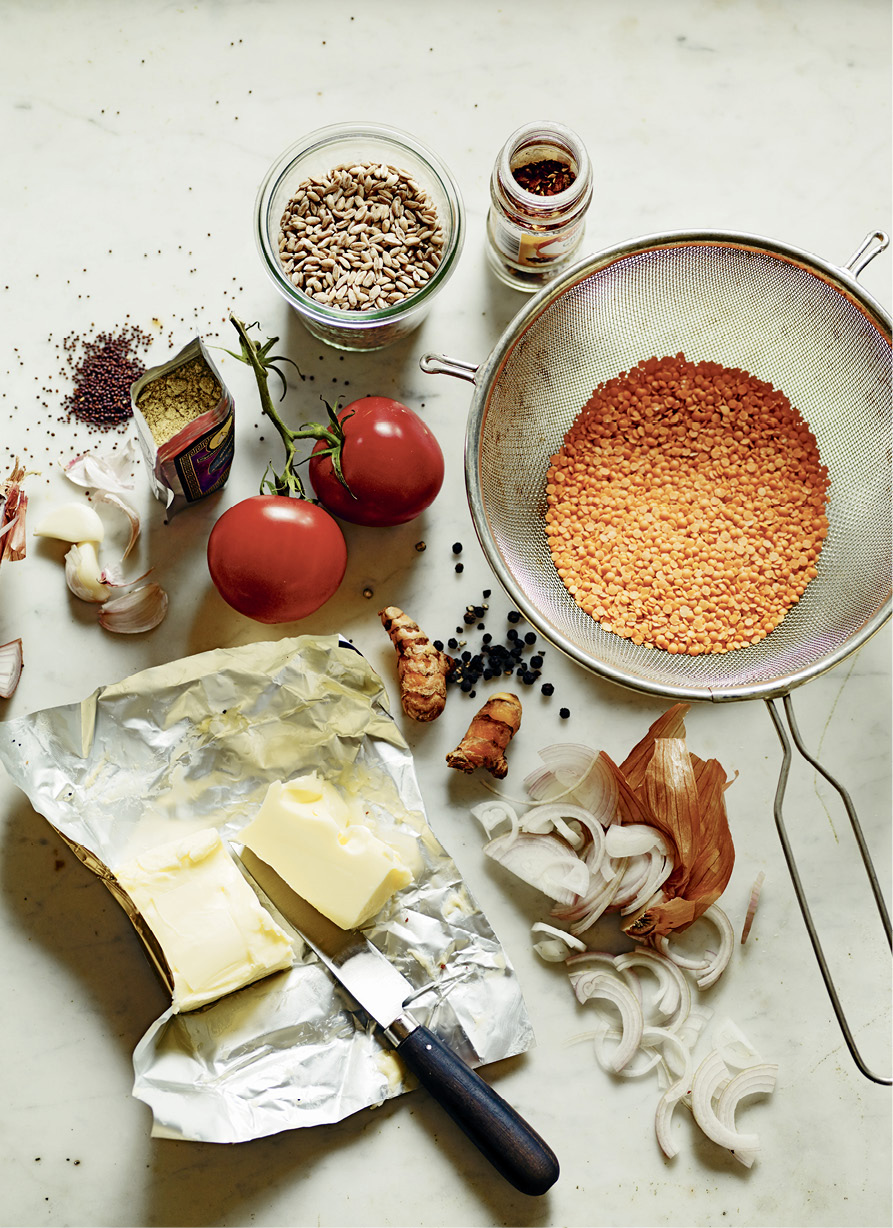
Tomato-Lentil Rasam with Spelt
In no way a traditional rasam, or even a traditional way to eat it. Rasam, a spiced, sour broth of sorts, is usually served in cups alongside a dal or similar, as a gentle, nutritious accompaniment. However, sometimes restorative suppers such as this are called for, and, with its spelt grains and burlier-than-average broth, this is also extremely cheap, assuming you have a good spice pantry to draw on.
Serves 4
• ½ cup (100 g) pearled spelt
• ½ cup (100 g) red lentils, rinsed
• ½- to 1-inch (1.3 to 2.5 cm) piece fresh turmeric, peeled and finely chopped, or ½ teaspoon ground turmeric
• 1 teaspoon black peppercorns
• 1 teaspoon cumin seeds
• 2 garlic cloves, peeled
• 1 tablespoon ghee or unsalted butter
• 3 shallots, finely sliced
• 1 teaspoon brown mustard seeds
• ½ teaspoon chile flakes
• Pinch of asafetida (hing), optional
• 3 medium tomatoes, chopped
• 1 tablespoon raw cane sugar
• 1 tablespoon tamarind purée (see Sweet-Sour Tamarind Sauce for how to soak and strain tamarind pulp)
• Sea salt
- Cover the spelt and lentils with 3½ cups (800 ml) of water in a small saucepan and bring to a boil. Cover, reduce the heat and simmer for 20 minutes, then add the turmeric and continue to simmer for 10 minutes more, until the lentils are very tender and the mixture is thick. Beat well with a wooden spoon to break the lentils down into a rough purée.
- Meanwhile, crush the peppercorns and cumin seeds with a mortar and pestle, adding the garlic cloves once the spices are crushed and pounding them, too, to a purée.
- Melt the ghee in a larger saucepan set over medium-high heat. Add the shallots, mustard seeds and chile flakes and cook, stirring often, for about 7 minutes, until the shallots begin to sizzle and the mustard seeds begin to pop. Stir in the spiced garlic mixture and asafetida, if using. Cook for a further minute. Add two thirds of the chopped tomatoes, the sugar and tamarind and cook for 2 minutes more.
- Pour in 1⅔ cups (400 ml) of water, season with salt and bring to a boil. Stir in the lentil mixture and remaining chopped tomatoes, reduce the heat and simmer for 5 minutes, until piping hot.
Vegetarian Pad Thai
You can make an excellent vegetarian pad Thai, and here it is. Of course, dried shrimp and fish sauce don’t feature, but you can make my Vegetarian “Fish” Sauce, or just use light soy sauce. The recipe only serves two and with good reason: Overfilling a wok causes the contents to steam and simmer rather than fry, making any stir-fry soggy. Successful pad Thai is made in small quantities.
Serves 2
• 3.5 ounces (100 g) flat rice noodles
• ⅓ cup (40 g) unsalted peanuts
• ¼ cup (60 g) tamarind purée (see Sweet-Sour Tamarind Sauce for how to soak and strain tamarind pulp)
• ¼ cup (60 ml) Vegetarian “Fish” Sauce, or light soy sauce
• 1 to 2 tablespoons palm sugar or brown sugar, to taste
• ½ teaspoon hot chili powder
• 3 tablespoons peanut oil
• 6 ounces (160 g) store-bought marinated tofu cubes (ideally those in tamari)
• 1 garlic clove, finely chopped
• 2 medium eggs
• 1 heaping tablespoon chopped, preserved radish, optional (from Thai groceries)
• 1 cup (100 g) bean sprouts
• 2 tablespoons chopped Chinese or garlic chives, scallion tops, or regular chives
• Lime wedges, to serve
- First, soak the rice noodles in plenty of lukewarm water for 20 minutes.
- Meanwhile, preheat the oven to 375°F (190°C), spread the peanuts out on a baking sheet and roast for 6 to 7 minutes, shaking the tray halfway through, until golden. Cool, then crush or chop quite finely.
- Put the tamarind purée, “fish” sauce and 1 tablespoon of the sugar in a small saucepan with 1 tablespoon of water. Heat gently for 5 minutes, then add the chili powder. Taste and stir in the remaining sugar, if you wish. There should be a good balance of salty, sour, sweet and hot.
- Drain the noodles thoroughly. Have the tamarind sauce on hand, with all the remaining prepared ingredients and a small dish of water.
- Set a wok over high heat and add 2 tablespoons of the peanut oil. Once smoking hot, throw in the tofu and stir-fry for a minute. Add the garlic and cook for a minute more. Add half the tamarind sauce and transfer the noodles into the wok. Stir-fry until the noodles just soften, adding a splash of water if they stick. Taste and add some or all of the remaining sauce, as needed. Push the noodles to the side of the wok and add the remaining oil. Crack the eggs into the base, stirring to scramble before letting them set into a makeshift omelet. Tumble the noodles and eggs together, throwing in half the peanuts, the preserved radish, if using, bean sprouts and chives at the same time.
- Toss through until the bean sprouts lose their raw look and serve immediately, with the remaining peanuts on top and lime wedges on the side.
Hor Fun Noodles with Many Mushrooms
Hor fun are the flat, wide rice noodles sold in fresh form in the refrigerated cases of Vietnamese, Chinese and Thai food shops. If you have a Chinatown near you, you’ll be in luck, but you can always use half the weight of readily available dried, flat rice noodles instead. Soak the latter in plenty of just-boiled water for about 10 minutes, or according to the package instructions, before using.
Serves 2
• 4 scallions
• 1 teaspoon cornstarch
• ⅔ cup (150 ml) vegetable stock
• 1 tablespoon light soy sauce
• 1 tablespoon mushroom ketchup, vegetarian oyster sauce or Worcestershire sauce
• 1 tablespoon Shaoxing rice wine
• 2 teaspoons sesame oil
• 1 teaspoon brown sugar
• Fat pinch of sea salt
• 3 tablespoons rice bran or peanut oil
• 7 ounces (200 g) fresh hor fun noodles, or 3.5 ounces (100 g) dried rice noodles
• 1 small onion, sliced
• ½- to 1-inch (1.3 to 2.5 cm) piece fresh ginger root, peeled and sliced into matchsticks
• 1 garlic clove, finely chopped
• 2 cups (150 g) torn shiitake or oyster mushrooms
• 3 cups (200 g) roughly chopped white or green cabbage
• ½ cup (50 g) bean sprouts
• 1 red chile, finely sliced
- Set the oven at a very low warming setting.
- Slice the scallions thinly, keeping the pale green and white parts separate from the dark green.
- Put the cornstarch in a container and gradually stir in the stock, soy sauce, mushroom ketchup, rice wine, sesame oil, sugar and salt.
- Have all the remaining ingredients prepared and sitting next to the stove. This is a quick stir-fry.
- Heat 1 tablespoon of the rice bran oil in a large wok over over high heat until smoking hot. Add the noodles and stir-fry briskly for a minute or so, using a spatula to separate them as they cook (it doesn’t matter if they break up a bit). Transfer out on a plate and return the wok to the high heat. Keep the noodles warm in the low oven.
- Add the remaining 2 tablespoons of oil to the wok and warm through. Throw in the onion and fry for 1 minute. Push to the side of the wok and add the ginger, garlic and pale parts of the scallion, cooking for a few seconds before adding the mushrooms. After barely 1 minute, add the cabbage and stir-fry for 20 seconds or so. Stir the cornstarch mixture and transfer into the wok, stirring well. Bring to a boil, then reduce the heat and simmer briskly for 3 to 4 minutes. Stir in the bean sprouts and warm through until they just wilt.
- Ladle over the warm noodles and scatter with the sliced chile and reserved, dark green scallion tops to serve.
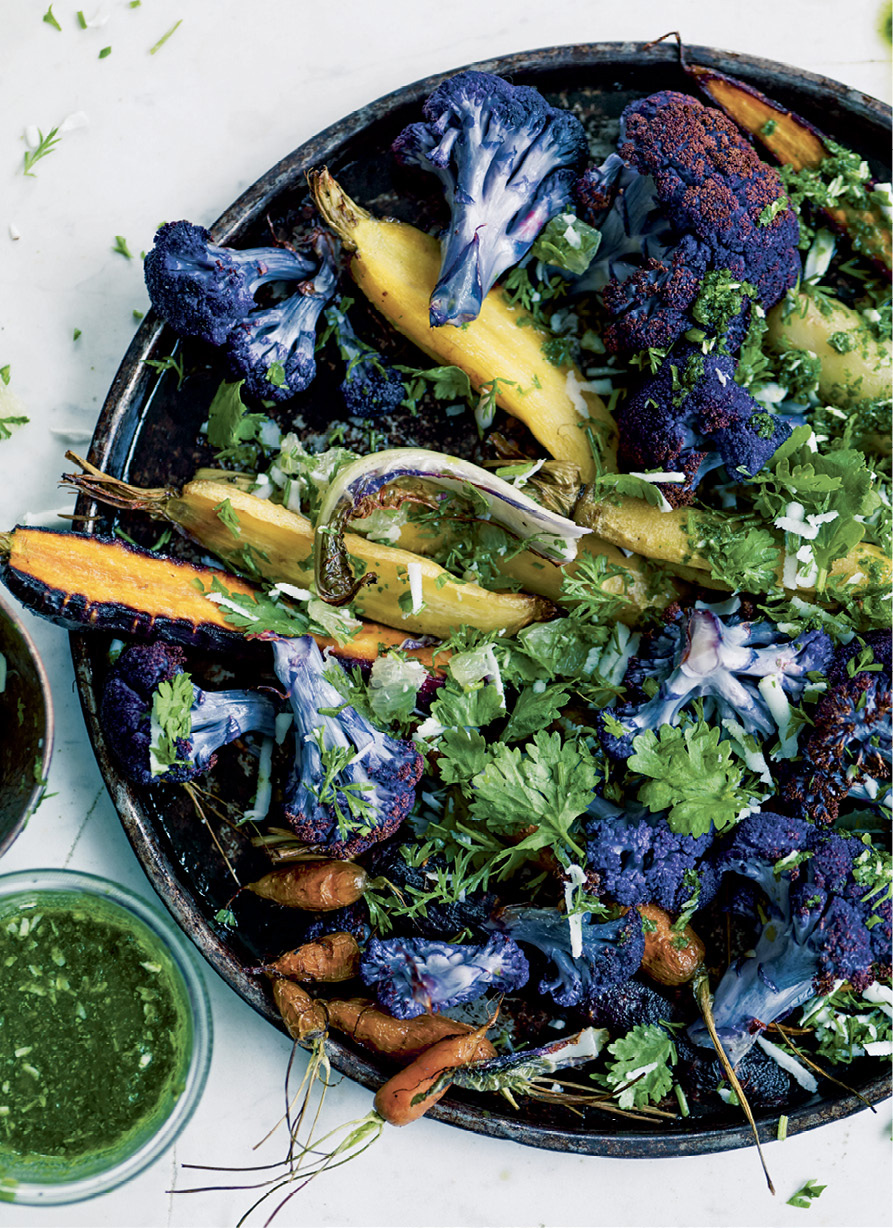
Roasted Cauliflower and Carrots with Lime Sambal and Cilantro Chutney
I tend to serve this with rice, simmered with a twinkle of coconut milk in the water and a scrunched-up lime leaf to scent, but pretty much any cooked grain or lentil would do. Or serve it as a starter without any accompaniment. And, of course, you don’t need to seek out the purple cauliflower and multicolored carrots shown in the picture; I couldn’t resist their garishness, but standard colors will taste the same.
Serves 4 with rice
• 2 bunches of carrots, trimmed, any leafy tops reserved
• 1 cauliflower, trimmed and separated into florets
• 2 tablespoons coconut butter, melted, or peanut oil
• Sea salt and freshly ground black pepper
• 2 limes
• 1 cup (90 g) coarsely grated fresh coconut
• 2 handfuls of cilantro, roughly chopped
• 2 green chiles, deseeded and finely chopped
• 1 to 2 teaspoons palm sugar or brown sugar, to taste
• 1 small garlic clove, crushed
• 1 tablespoon desiccated coconut
- Preheat the oven to 425°F (220°C).
- On a large baking sheet, toss the carrots and cauliflower florets with the melted coconut butter. Season with salt and pepper, spread out well and roast for about 30 minutes, until soft and sweet.
- Meanwhile, make a little sambal. Finely grate the zest of 1 of the limes, then pare the skin and pith from the sides and remove the segments, discarding the tough membranes holding them together. Roughly chop the flesh and transfer to a mixing bowl with the zest. Finely chop a handful of the reserved and rinsed carrot tops and add to the mixing bowl with the grated coconut, 1 handful of chopped cilantro and 1 finely chopped green chile. Season with salt, pepper and sugar to taste.
- For the chutney, pulse the remaining cilantro in a mini food processor with the garlic, the juice of the second lime and a pinch of salt. Add a splash of water to get the blades moving; it should have a very loose consistency. Stir in the desiccated coconut and season to taste.
- Serve the roasted vegetables with all the sambal and some of the cilantro chutney spooned over. The remaining chutney can sit on the side, ready to add as wanted.
Penne with Asparagus Pesto and White Beans
Replace half the basil used in this recipe with mint leaves, if you like; this is a summery affair, intended to coincide with the latter part of asparagus season when the spears are plentiful and cheap. Use any almonds you have in the pesto: Sliced, blanched, chopped or whole with skins all work well. Never drain pasta too thoroughly, as the starchy cooking water helps to form a sauce.
Serves 4
• 10.5 ounces (300 g; 1 large bunch) asparagus
• Sea salt and freshly ground black pepper
• 12 ounces (350 g) whole wheat dried penne, or other short pasta shape
• Olive oil
• 1 garlic clove, chopped
• ¼ cup (25 g) almonds
• 2 small bunches of basil
• Finely grated zest and juice of 1 unwaxed lemon
• 3 tablespoons extra virgin olive oil
• ½ cup (50 g) finely grated vegetarian Parmesan cheese, plus more to serve
• One 15-ounce (400 g) can lima or cannellini beans, drained and rinsed
- Trim the very ends from each asparagus spear, only removing more if they are woody. Cut off the tips with about a thumb’s length of stalk. Set aside.
- Bring a medium saucepan of water to a boil, add the trimmed asparagus stalks (not the tips) with a good seasoning of salt and boil for 5 minutes, or until tender. Scoop the stalks out and into a colander with a slotted spoon, leaving the water behind in the pan. Give the stalks a brief rinse under cool water, just to take their temperature down a little, and transfer into the bowl of a food processor.
- Return the pan of asparagus water to the heat, topping it up if needed. Bring to a boil and add the pasta, cooking according to the package instructions, or until al dente.
- Set a griddle pan over high heat until smoking, toss the asparagus tips with a little regular olive oil to coat lightly and griddle for 4 minutes, turning now and then, until colored and soft. Set aside in the pan.
- Put the garlic, almonds, almost all the basil (reserving a few leaves to serve), a squeeze of lemon juice and the extra virgin olive oil into the food processor with the asparagus stalks and blend to a rough purée, stopping to scrape down the sides a couple of times. Stir in the lemon zest and Parmesan. Taste and season, stirring in more lemon juice if you like.
- Drain the pasta—not too well—and return to the hot pan with the beans and the asparagus pesto. Warm through very gently, then divide between warmed bowls or plates with the griddled asparagus tips, the reserved basil leaves and more cheese.
Spinach Gnocchi with Parmesan and Samphire
Your aim, when making toothsome gnocchi, is to extrude water from the dough at every stage. The more you can remove, the less flour you will have to add . . . which gives a light result. Ricing the potatoes when hot does give slightly airier dumplings, but, really, you can get away with baking the spuds in advance and ricing them when cool if that works better for you, time-wise.
Serves 4 / Makes about 40
• 2 pounds 10 ounces (1.2 kg; about 4) baking potatoes
• Sea salt and freshly ground black pepper
• 1 pound (450 g) spinach
• 1 cup (130 g) spelt flour, or as needed, plus more to dust
• 3 tablespoons finely grated vegetarian Parmesan cheese, plus more to serve
• Good grating of nutmeg
• 1 egg, lightly beaten
• 2 tablespoons olive oil, plus more for the tray
• 1¾ cups (250 g) halved cherry tomatoes
• 1 garlic clove, finely chopped
• 2.5 ounces (75 g) tender samphire or baby asparagus, rinsed
• Handful of basil leaves
- Preheat the oven to 400°F (200°C). Prick the potatoes a few times with a knife and bake for 50 to 60 minutes, depending on size, until tender. Gingerly slice the cooked spuds in half, being careful not to burn yourself. Scoop the insides out with a spoon, leaving the empty skins behind. (Toss these with olive oil, season and bake until crisp. Cook’s treat.) Using a potato ricer—failing that, a masher—rice the potato flesh into a bowl. Let cool for 5 minutes so it doesn’t scramble the egg when you add it.
- Meanwhile, bring a large saucepan of salted water to a boil. Submerge the spinach in it, reduce the heat and simmer for a minute or so to wilt. Drain in a colander, refresh briefly under the cool tap and drain again. Squeeze the leaves out over the sink, then transfer into a clean kitchen towel and twist for all you’re worth to squeeze out excess water. Chop the dry spinach leaves very finely.
- Add the spinach, flour and Parmesan to the potato with a generous seasoning of nutmeg, salt and pepper. Mix lightly, then add the egg and combine to form a dough. If it is very sticky, add a little more flour, but only if strictly necessary. Divide into 4 pieces. Roll each piece into a 1-inch (3 cm) thick cylinder on a lightly floured surface. Cut each into about 10 gnocchi.
- Bring a large saucepan of salted water to a boil (again) and gently add the gnocchi in 3 batches, cooking each until they float to the surface and simmer there for 2 minutes. Fish out to an oiled tray with a slotted spoon and cook the next batch until they are all done.
- Put a large frying pan over medium-high heat and add the 2 tablespoons of olive oil. Throw in the tomatoes and garlic and cook for a few minutes until the tomatoes begin to break down. Stir in the samphire and cook for a minute or so, followed by the gnocchi, basil and plenty of black pepper. Toss the pan cautiously to coat the gnocchi in sauce, heating everything through, but being gentle. Serve immediately with more cheese, if you like.
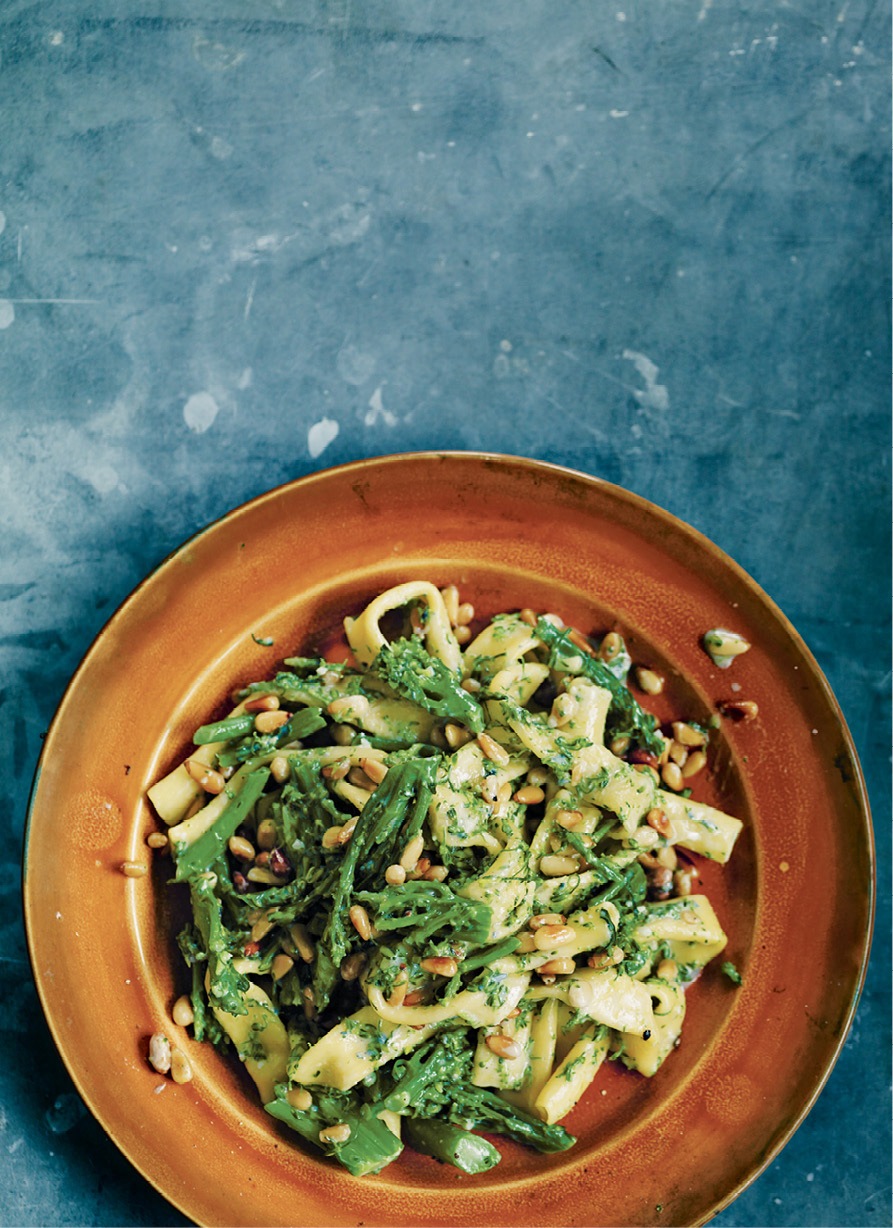
Ziti with Broccoli and Toasted Pine Nuts
Don’t be scared of cooking the broccoli here until truly soft; it doesn’t take long, and, as you want it to form a sauce for the pasta; this is not the time for fancy al dente vegetables. It is also the authentic Italian way, when using broccoli as part of a pasta dressing. If you are after a rich sauce, include the mascarpone but, if you prefer a lighter pasta, feel free to leave it out.
Serves 4
• 6 cups (400 g) broccoli florets
• 12 ounces (350 g) dried ziti pasta, or other long pasta shape
• Sea salt and freshly ground black pepper
• 2 tablespoons salted butter
• 1 fat garlic clove, crushed
• 2 tablespoons mascarpone, optional
• ⅔ cup (100 g) roughly chopped vegetarian blue cheese, such as gorgonzola
• 1⅓ cups (100 g) pine nuts, toasted until golden (see Rye Toasts with Pine Nut Butter and Avocado)
• Vegetarian Parmesan cheese, finely grated, to serve, optional
- Blanch the broccoli in plenty of boiling water for 3 minutes or so. Drain in a colander and refresh under ice-cold water to preserve its color. Drain again and roughly chop.
- Cook the pasta in plenty of boiling salted water for 10 to 12 minutes, or according to the package instructions, until al dente.
- Meanwhile, put the butter and garlic into a cold large frying pan, place over medium heat and cook for a minute or so, until the garlic is fragrant but not browned. Add the broccoli, cover with a lid or baking sheet and cook very gently for a few minutes. The broccoli should be very soft and yield easily to a wooden spoon pressed on it. Stir in the mascarpone, if using, and blue cheese and heat through to form a sauce. Season with salt and lots of pepper to taste. Stir in the pine nuts.
- Drain the pasta, but don’t be too precious about draining off every drop of water. Transfer the pasta straight into the broccoli pan and mix well. Serve in warmed bowls, with vegetarian Parmesan cheese grated over, if you like.
